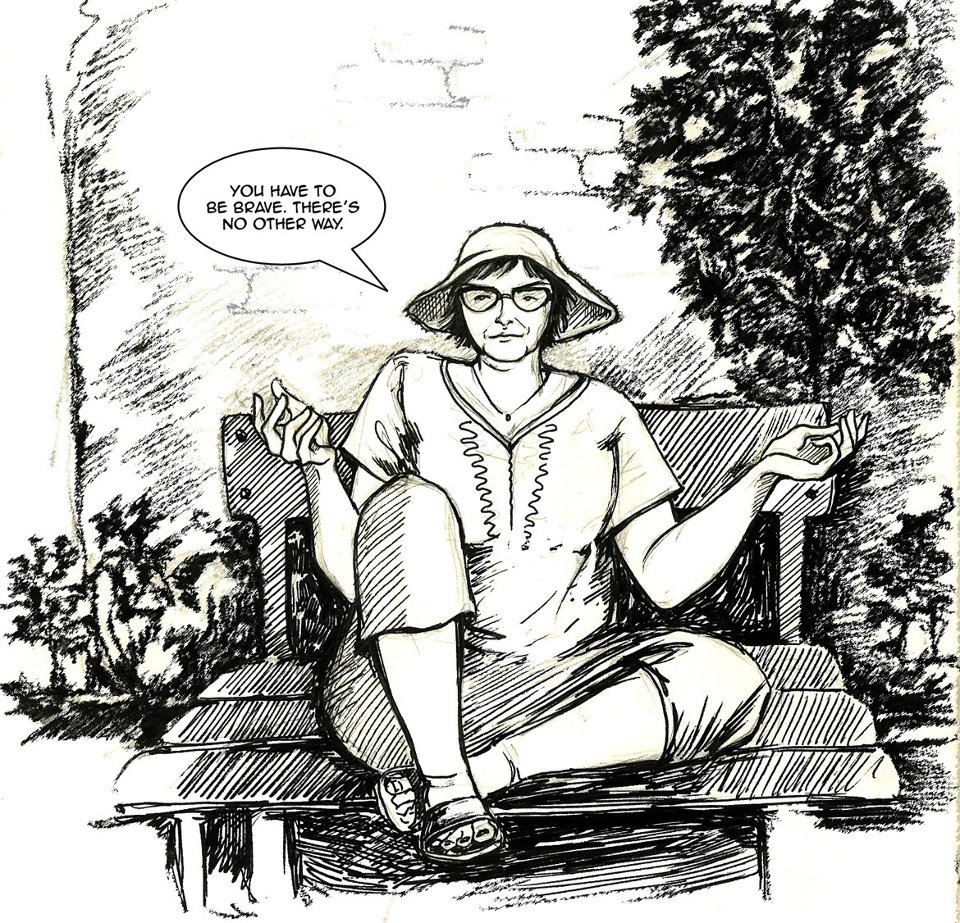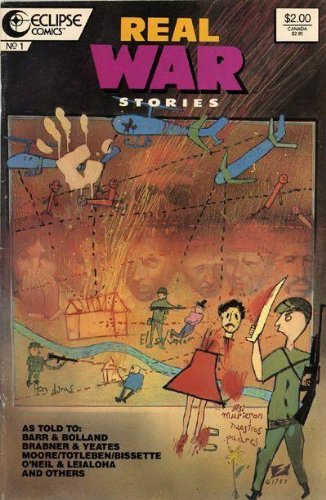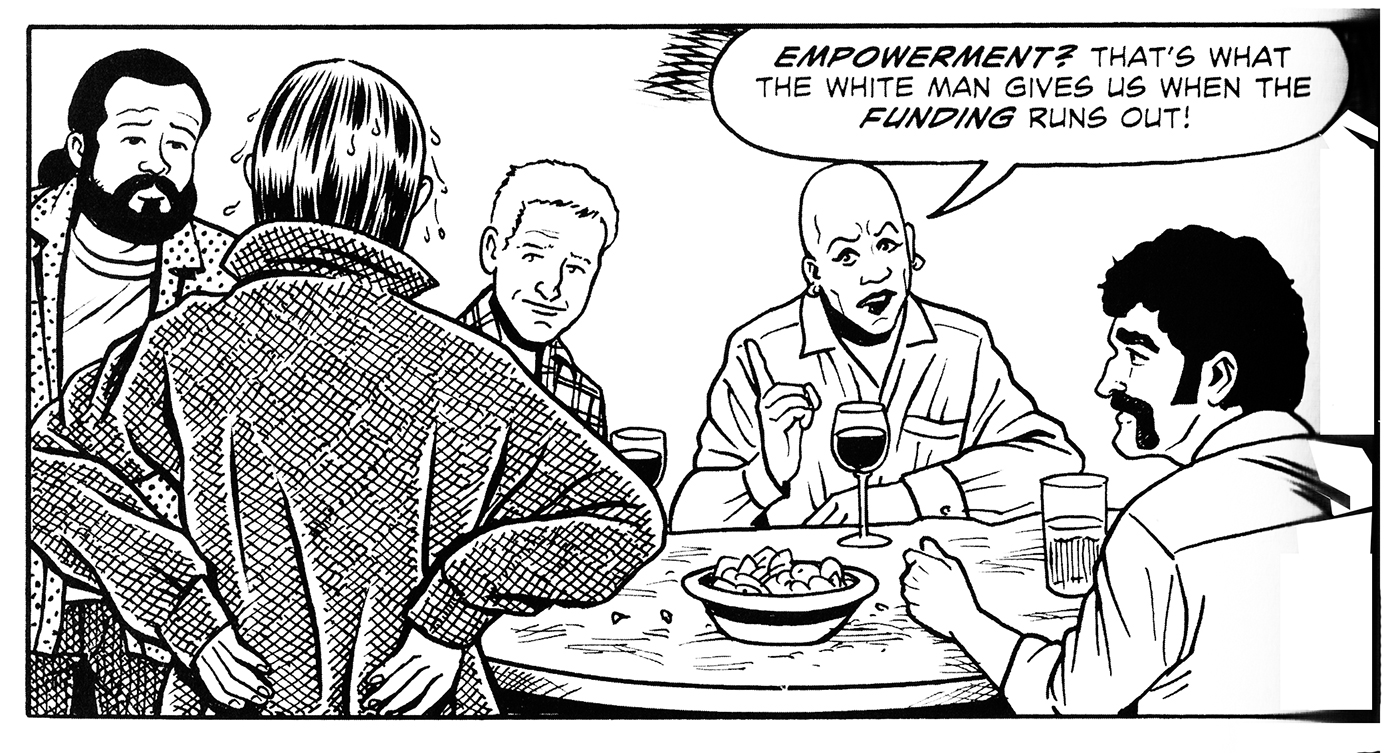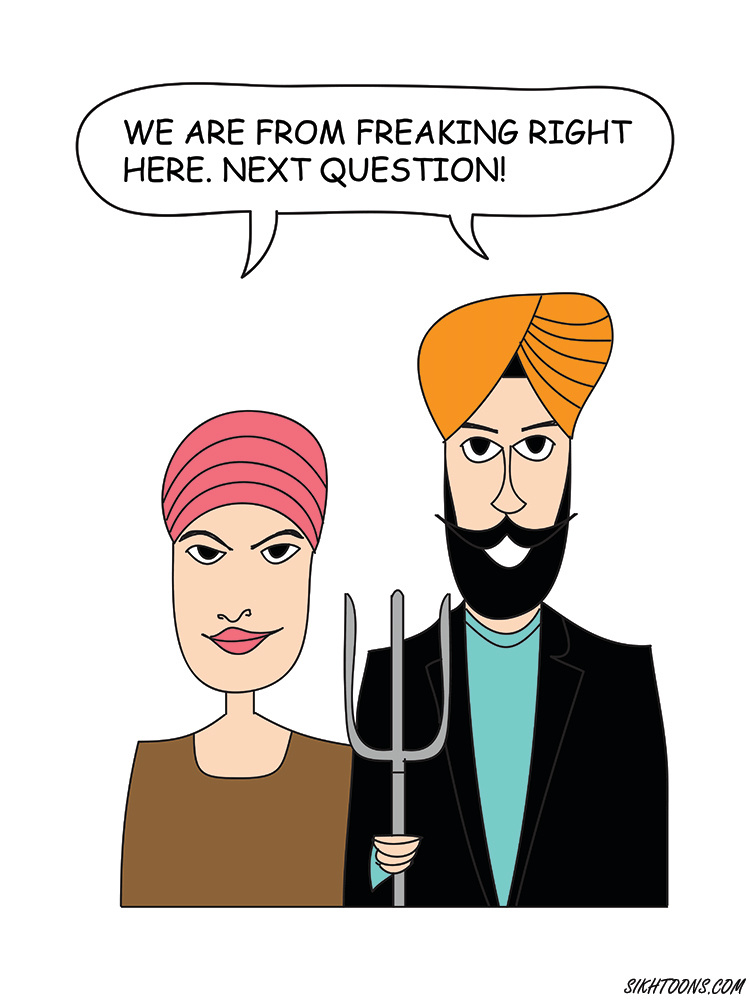A Life in Activism and Comics: An Interview with Joyce Brabner

Joyce Brabner, drawn by artist Gerta Opakaru (image courtesy Joyce Brabner and Gerta Opakaru)
Brabner is best known as the wife and supporting force of comics legend Harvey Pekar, whose long-running series, American Splendor, rewrote the rules of what comics could be. That’s a role she took very seriously throughout their 26 years of married life, especially when Pekar became ill, three times, with cancer. But Brabner is also a creator in her own right: Before meeting Harvey, she ran cultural programs for prisoners and a theater; she’s made costumes and comics and been a writer her whole life. (And she maintains a glorious garden, I’m told.) Her work is less well-known and, in a way, less public than Pekar’s, but at the same time carries a sense of public engagement that his never did. Pekar’s work was landmark for being autobiographical; he stayed mostly close to home, looking inward and at his immediate surroundings for inspiration. Brabner, on the other hand, is an activist. She looks out, well beyond the confines of Cleveland Heights, to make work that’s capital-p Political. Her published comics include Real War Stories (1987), a book of counter-army propaganda that tells the stories of Vietnam vets; Brought to Light (1988), two volumes disclosing the CIA’s covert involvement in political affairs around the world; and Second Avenue Caper (2014), the story of how a group of artists and activists in New York City attempted to fight AIDS in the early years of the epidemic.

A cartoon by Morgan Pielli for Comixcast RNC 2016 (image via comixcast.com)
Brabner and I met last month when the comixcast was still the germ of an idea, a mere two days after she had conceived it. I was in Cleveland as the art-writer-in-residence at SPACES and called her up to ask if we could talk. She instructed me to meet her at the Cleveland Heights-University Heights Public Library, in front of a memorial statue and desk that she’d gotten installed in 2012 in honor of Pekar, who had loved the library and worked there often. I could tell that Brabner loved it too; when she arrived, the first thing she wanted to do was walk me around the place, showing me its many resources and charms. Only after that was done could we sit down to talk — about her career, Harvey, comics, feminism, and much, much more.
* * *
Jillian Steinhauer: Let me give you a
little bit of background on where I’m coming from: I’ve been covering
comics for about 10 years. It’s not my primary thing. I do a lot of art
stuff, but I read a lot of comics.
Joyce Brabner: Comics aren’t my primary
thing either. Or, as [comics artist] Dean Haspiel said, “You don’t have
to make comics. You have a life.” I’d so much rather show you my garden.
JS: I would love to see your garden.
But I think a lot about art and activism, and so I find your work really
interesting. I’d love to talk to you about it.
JB: All right. Well, I’m an activist, and
I’ve been one since I was 15 and something made me so angry that I
developed a voice and stood up and did something. While we made it look
kind of funny in the movies, I was pretty effective in working on
feminist issues and with people in prison.
So, when I married Harvey, I had this great job that the
commissioner and the governor had created for me — I was doing cultural
programming in support of treatment objectives. I started using theater
and some other stuff. If a guard said to me, “We have a problem because
these older guys are getting pushed off the basketball court by the
young jitterbug,” that was time for the master’s chess championship with
prizes. The women’s prison was unfit to live in, so I had a two-year
grant to redesign the prison by creating collapsible furniture out of
cardboard and things they had — a stray cubby, a desk, a chair. In the
women’s prison we did stuff like introduce carpentry and pave the way
for women getting ready for hard-hat occupations when they got out.
JS: Where was this?
JB: This was all in Delaware. I was asked
to be an advisor to Joe Biden on corrections, and I held a commission
from Pete du Pont. I have a talent for getting different groups of
people working together, and I have a talent for seeing systems — whole
systems — and putting things together quickly. That’s how I made all of
that work.
When I married Harvey, the first thing I did was relax, because I wasn’t really in the public eye.
JS: You also moved to Cleveland.

Harvey
Pekar’s memorial statue, designed by Justin Coulter, and desk at the
Cleveland Heights-University Heights Library (photo by the author for
Hyperallergic) (click to enlarge)
JB: Yeah, I moved to Cleveland. I offered
to support him, but he was too entrenched and really wary. He didn’t
expect a relationship with a woman to succeed. I’m the real goods. I’m
loyal. We talked about the Alzheimer’s [that ran in Pekar’s family], and
I said, “I’ll manage. I’ve managed worse before.”
JS: You seem good at managing.
JB: Yeah. That’s the one thing I found
out … Mentors helped from time to time, for short periods, but a lot of
time mentors didn’t have the class background or understanding. I’m from
a family that started down here [gestures below waist] but
accelerated really quickly by way of higher education. In fact, my dad
became a PhD professor, but where we started from was him being a guy
with a $500 scholarship to Yale that the city wanted to take away
because it would be a waste on a boy from that kind of family. It was
rocky.
JS: It sounds it.
JB: My mother’s situation is she’s a
brilliant autodidact who did everything for the library — which is why
we love libraries. She couldn’t figure out how she was going to feed her
large family. I’m the oldest of a whole lot of kids. She sat there and
said, “OK, I don’t have enough money to feed my kids, but there are
people in other countries who are poorer than we are who do things like
hard labor, and they eat and they work.”
She began to study other kinds of foods and nutrition.
What today is called “peasant cuisine” — the quinoa and grains and stuff
like that — well, there are the Brabner kids eating meals of kidney
beans and cottage cheese together because she figured out what was
protein and made it all creative and fun. That woman could give you
potatoes every day of the week and be different. The trick was — and
I’ll tell the world — get a tiny bit of money, go to those dark stores
and, in the back, buy some kind of spice, something that you can just
keep flavoring your ramen or rice with.
Going to libraries for help was a core part of my
existence, going there for sanctuary. I had no problem with somebody
like Harvey, who was self-educated without a formal education. In fact, I
respected him more. I just have some degree, a BA with high honors or
something, from a land-grant university. At different times people tried
to arrange for me to go to law school or something else. I said no. I
need to have a couple of things, and these were all articulated when I
was 15. I kept a diary all the time.
JS: Always a writer.
JB: Yeah, that’s it. The first thing I
ever wrote was “Baby in the Rosebush” — a story I narrated to my mother
after cutting out some pictures of a little baby. I had just gotten a
baby sister, and the baby [in the story] crawls into the rosebush and
goes, “Ow ow.” Mother goes, “Oh oh.” At that time I was writing what I
had been given, which was children’s picture books. I soon switched over
to a more sophisticated narrative form. I was working with words and
pictures.
JS: That’s a comic.
JB: Well, comics were fascinating to me. I
had a cousin who had a collection of them, and we would hide from the
grownups and read these things. We both swore we would grow up to be
hermits and just read books. Comics were interesting and cool, but what I
really liked was Mad magazine that showed adults doing strange
things. There I am, eight years old, looking at JFK and Khrushchev
dancing together to West Side Story.
Alright, now here are the things: I wanted to do something
for social change. You know, something for good. To put forward rather
than take away. I wanted — and this was just too early for the punks — a
purple mustache tattoo like the hairy Ainu, which would guarantee I
would never be able to be employed as a sales clerk selling things I
didn’t want. It later occurred to me that I could just not take those
jobs. I would never have debt, because when you come from a poverty
background that really can scare the shit out of you. I would, if I ever
got that door open — this was important — I would hold the door open
for as long as I could for anybody to come in behind me.
Harvey was the same way, because our attitudes about
celebrity, and particularly mine, is that celebrity is only good if it
gets you your next job and lets you get your buddy hired. Otherwise it
just means a bunch of assholes know your name. It doesn’t mean money.
Money doesn’t mean power. It doesn’t really mean security.
I don’t know how I got here. I don’t know how I made it
happen. I don’t know how I got to be somebody who owns a house. I don’t
know how I got to be somebody who has a shelf full of books. I don’t
know how I got to be somebody who people can look up and see a picture
of me and my name. I can look backwards and say, well, I was a case
worker. I felt myself burning out. When I burned out, I joined my friend
who was into comics, Tom Watkins, and I made monster costumes and ran a
cinematheque and did costumes for John Waters and all this other
creative stuff to let that other side of my brain relax. When I’m not
doing the writing stuff, I’m making arts or pictures or things.
JS: It’s great that you have both sides of your brain like that.
JB: Everybody does. Everybody can do
these things; they just need to be encouraged. Fortunately, I came from a
family where we made our own toys and fun. So, the thing is, I don’t
know how I got here. But if I did get here, maybe I know what I’m doing.
If I can get you through here, then yeah, maybe I really know what I’m
doing. And the more I increase the chances that I know what I’m doing,
the safer I’m probably going to be, because life is going to continue to
throw me all kinds of curve balls and disasters.
Understanding feminism, well, I figured that out when I
was about 14 or 15. There’s this lovely passage [in my diary] in which
I’m writing — I think it’s 1966 or 1967 — “I have been chosen to be the
assistant to the student producer of the high school play.” Now he was a
pretentious little soot who — I am not kidding — showed up in jodhpurs
and said things like, “People, people,” and kept referring back to his
experience in summer stock. He would constantly throw tantrums. And I
said, “My job is to keep the great man calm so that he can invent, he
can create. My job is to bring him Cokes.” And I wrote down, “This
sucks. I should have this job. What we really need are suffragists.” Of
course, later, women’s liberation came on and helped me articulate that.
JS: That’s really impressive for a 15-year-old. I was not that aware when I was 15.
JB: When you’re a loner, when you’re
moving from a different place every year and your parents are kind of …
hiding, you can get pretty deep down inside yourself.
JS: We left off at you marrying Harvey. Was he the reason you started making comics?

The cover of ‘Real War Stories’
JB: Well, no, I read his comics. I was
not really emotionally attached to comics. One day [after she and Harvey
were married] a woman named Lou Ann Merkle, who was herself an artist,
came to Harvey for advice about printing a collection of comics about US
militarism that she wanted to hand out to kids at schools, on behalf of
the Central Committee for Conscientious Objectors. We had just begun
the all-volunteer army, and there was a very sophisticated ad campaign.
Harvey was telling her where he got things printed and the
process, which … God, the internet would have made it so much easier.
In those days it was: get the film shot at one place, get the guts shot
at a press that did newspapers, bring those to a magazine place, have
them bound. Being careful, because interfiled in every 25 pages they put
whatever else they were printing, which was usually stuff like North Coast Swinger. If you weren’t careful, American Splendor would go out with pictures of Clevelanders showing their boobs and asking for dates.
Anyway, he was explaining that and — look, I told you. I have a talent. I see whole systems. I said, “This is totally wrong.”
JS: I’m sure she appreciated that.
JB: Well, Harvey said, “Listen to her.
She’s smart.” I said, “This is totally wrong and I’ll tell you why and
I’ll help you.” Kids are being seduced because of economic insecurity.
If you give them something in newsprint with scratchy, artsy,
underground illustration, and courier typeface pasted in, and put it up
against the flashy recruitment flyers, they’re going to think, “Well,
you’re not an economic success. You can’t even afford to print good
media.”
I said, what we can do instead is make comics, and the
writing will be to journalistic standards. We’ll take these
storytellers, people Lou Ann knew like combat vets, and I said, “I can
get the guys that do Batman and Superman to draw this stuff. I can get this different group to work.” Now here’s the problem: Batman and Superman
people had been trying to do significant comics, and they had failed
miserably, because they had no clue about the material. One case was
Superman against the famine in Biafra, where no Biafrans have any
voices; they’re just these big-eyed baby dolls. Famine is like a ghost.
You don’t talk about anything like warlords or grain shortage; it just
sort of happens. In the end, Superman is overwhelmed and says, “It will
only be cured if we all work together.”
What I did was, because of my teaching abilities, I made
them all [the comics artists] understand it. I said, “You have the
ability to sell the same story every month. Flying guy saves world. I’m
going to give you all the details, but I want you to do it in a creative
way and use your storytelling thing.”
That comic book looked good. 65,000 copies went out, and I
still, to this day, hear from people who say, “I read it and I changed
my mind about how I was going to get my college money.”
JS: That’s amazing. So what was next?
JB: Brought to Light, the Iran-Contra book.
JS: Who initiated that? Was it your idea?
JB: Yeah, what happened was, Danny
Sheehan was speaking around the country. I watched the way he was
dealing with audiences, and I saw that there are two ways to appeal to
people. One was this whole conspiracy, all these evil people, which is
the side that Alan took. [Brought to Light is comprised of two
books, one by Alan Moore and Bill Sienkiewicz, the other by Brabner and
Tom Yeates]. The other was the down-to-earth story of these two
journalists who were trying to find out how they got hurt. I took that.
JS: After Brought to Light there was a bit of a break, right?
JB: Well, Harvey had cancer. It was really horrible and much worse than anybody knew. Then we did Our Cancer Year.
JS: What was it like collaborating? I know you were so well-matched, but also, you seem to look out and he looked in.
JB: Well, first of all, when you read the
book without knowing who Harvey or Joyce are, you can see that it
really is by Joyce Brabner with Harvey. But the joke we had was: it’s
Harvey’s cancer. Harvey had to shake and bake, and I helped. The truth
is he didn’t really remember a whole lot of stuff in order to write
about it. He was terribly ill. We were trying to escape from a
nightmare, but we’re there mining our misery for dramatic purpose.
The thing is, it wasn’t the worst thing that could happen
to anybody. We knew. Our friends had been dying of AIDS. I had been
dealing with kids from the Khmer Rouge. We knew he had a pretty good
chance of making it if we could just keep him in treatment. He freaked
out in the middle. That’s kind of when the Alzheimer’s was starting to
tip in. He was hallucinating and everything else. I thought, you know, I
may not get him back. There was nobody to help me or anything.

A photo and plaque dedicated to Harvey at the Cleveland Heights-University Heights Public Library (click to enlarge)
I didn’t handle the next cancer like that. The next one I
made sure I had help. What would have been the third one — he died when
he would have started treatment, and I don’t believe he would have
survived the cancer. It would have been long, and he was deteriorating.
It was kind of a thing he did by dying suddenly, but it was absolutely
awful. No, no, no, no, he did not kill himself. No, dear internet, it
was not assisted suicide. No, it wasn’t the psych drugs, because he got,
like, a celebrity pass on the autopsy. What killed him was an overdose
of these generic Excedrins that he was taking like mints, maybe five or
six at a time, even though I hid them. I still found them, behind the
pudding and in the basement.
JS: Oy.
JB: Well, he was nuts.
JS: Do you feel like you put your career on hold for a while?
JB: Did I put my writing career on hold?
No. I say that I didn’t write during this time because any work that a
woman does has value. I had this kid [their foster daughter, Danielle]
who came to me with a lot of big needs, and I just stopped everything to
help her out of some horrible stuff. And we toured and made a movie.
But any work a woman does has value. How many times does
Patti Smith have to tell you guys that she was a musician even though
she washed toilets? It’s just what I chose to do. What’s feminist is
choice.
There’s other stuff that goes on, where people were harder
on me about my work than on Harvey because I’m female. I don’t care.
I’ll just keep working. Second Avenue Caper I had begun doing
because Danielle was out of the house. It was also a story that I felt
was imperative that be told. Ray [the protagonist of the book] was
critically ill. I needed to get this out, and I needed to get money for
him. It was important to get that book out, not just because of AIDS.

A panel from ‘Second Avenue Caper,’ written by Joyce Brabner and drawn by Mark Zingarelli (via adastracomix.com)
JS: Is there something that you think makes comics especially well-suited to this kind of work, to activism?
JB: Well, I tell people that they’re
back-pocket documentaries, and I’m done before somebody has to rent a
crane for a bird’s-eye shot. I tell them it’s what I have learned how to
do. It’s something I value. I based my marriage on a comic book. I
didn’t realize at the time I was looking at it that Harvey was single,
but this thing that goes off in my head at different times said, this guy is going to be somehow important to you. I
was open to writing to Harvey, and when I found myself sending him an
order, I just threw out a question. He answered, and we did this
correspondence.
Yeah, I value comics. Maybe it’s a family tradition. You
can do anything with words and pictures. That’s the motto in our house —
that and what I put on Harvey’s tombstone: “Life is about women, work,
and being creative.” Life is about love, work, and making art.
JS: So, I
saw a mysterious post on your Facebook page about a project for the
Republication National Convention. Can you tell me what you’re working
on?

A cartoon by Vishavjit Singh for Comixcast RNC 2016 (image via comixcast.com)
JB: An elite multicultural crew of
artists are coming here to make comics on a daily basis about the RNC.
We will be comixcasting on a daily basis — making comics and posting
them online. We’ll also be doing little flash YouTube videos of what we
see and hear. Once we get the thing rolling, we are opening it up to
worldwide comics artists and writers to send things through.
I’m lining up transportation, because I’m not saying we
only want the big-ticket people — I want people chosen because of who
they represent and who they understand. And there will be people that I
will introduce them to, so if they want to go and talk to folks about
the Tamir Rice shooting and what they expect from their candidates about
Black Lives Matter … My job is to make sure that when these artists
land here, they have a companion suitable for watching their back.
JS: You also mentioned another book you’re working on, with your collaborator in Albania, Gerta Opakaru.
JB: It’s called The Courage Party.
I’ve had to walk away from a couple of publishers because, although
they start off being warm and enthusiastic, they chicken out. Because
this is a book for young people and their parents about sexual assault.
It’s not a cute book with, “Don’t touch my bathing suit parts.” It’s got
words like “stirrups,” “gynecologist,” “penis,” “vagina.” It explains,
at a kid-appropriate level, the difference between sexual intercourse
and sexual assault.
It’s a true story. After I rescued Danielle and brought
her to Cleveland Heights, she went to play basketball one day. A big boy
took over the game. He threw the basketball out in the woods and said,
“Come on, let’s go get it.”
Now, I think he was expecting a marshmallow suburban kid,
and she was tough as nails. So she fought back and ran directly home to
me, screaming. She did everything right. I heard that note in her voice,
and I knew immediately what had happened. You just know, woman to
woman.
I also knew that however I presented
myself was going to affect how she thought about the whole thing for the
rest of her life. So I was completely calm. I told her she’s never a
victim; she’s a survivor. I gave her a courage metal to wear around her
neck. I also gave her a courage party. We invited our best women friends
to come to it, to tell stories, and to listen.
It’s not just a comic book; it’s a hybrid, because it’s got text,
illustration, sequential art. Everybody talks about trying to break the
comics form. I would like to see illustrated children’s books that are
not just these stupid little cartoony scribbles.
JS: What happened with Danielle’s case?
JB: The guy was identified. In the very
end, the judge asked Danielle, “What do you want to do to this guy who
hurt you so much?” She wasn’t prepared for that. “Could you maybe take
away his radio-listening privileges for two weeks?” By that time, it had
become bad behavior on a level that she understood. That’s when I knew I
did it right.
She didn’t want to lock him up; she just wanted him to get
the same kind of punishment she did if she did something wrong. That
was OK. We put it where it was supposed to be. I used all the things
that had hurt me to help her. That’s the kind of stuff I want to be
doing.





